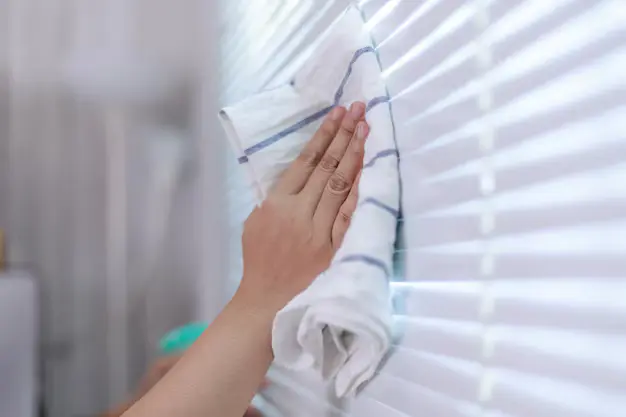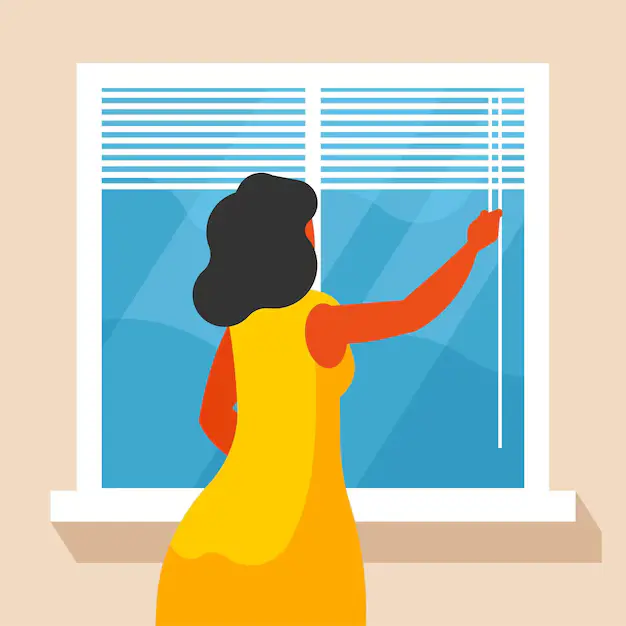Introduction: Why Clean Vertical Blinds Matter
Vertical blinds are a sleek and stylish way to control light and maintain privacy in your home. Whether they’re covering a door, a large window, or sliding glass panels, vertical blinds add a modern touch to any space. But over time, they also attract dust, grime, pet hair, and even mold, especially in high-humidity areas like kitchens and bathrooms.
Unlike most homeowners, you might overlook your blinds during the regular cleaning routine. However, learning how to clean vertical blinds properly not only extends their life but also enhances the overall cleanliness of your home.
In this ultimate step-by-step guide, you’ll get the answer to your question of how to clean vertical blinds using the right techniques and tools for a safe and spotless clean.
Different Types of Blind
Before diving into the cleaning process, it’s essential to know what your vertical blinds are made of. Different materials require different care, and cleaning them the wrong way can cause damage such as discoloration, warping, or shrinkage. Identify the material first, so you’ll be able to choose the safest and most effective cleaning method.
Common Types of Vertical Blind Materials
- Vinyl: Vinyl blinds are one of the most popular options because they are durable, affordable, and moisture-resistant. They are also the easiest to clean since dust and dirt can be wiped off with a damp cloth or mild cleaning solution without risk of damage. Vinyl blinds are especially suitable for kitchens and bathrooms where humidity levels are higher.
- Fabric: Fabric blinds offer a softer, more decorative look, but they tend to attract dust, absorb odors, and stain more easily than other materials. Depending on the fabric type, they may require vacuuming with a brush attachment or even professional cleaning. Spot cleaning should be done carefully to avoid watermarks or uneven patches.
- Aluminum: Lightweight yet sturdy, aluminum blinds are rust-resistant and often used in offices or modern homes. They don’t absorb moisture and can be wiped clean with a cloth, but their thin slats can bend if handled too roughly. Regular dusting or a gentle wash keeps them looking sleek without much effort.
- Wood (or faux wood): Wood blinds add warmth and elegance to any room, but they require careful handling. Natural wood can warp, crack, or discolor if exposed to too much moisture. Instead of water, it’s best to use a dry cloth or a wood-safe cleaner. Faux wood, however, is more resistant to moisture and easier to maintain, making it a practical alternative.
By identifying the material of your vertical blinds first, you’ll avoid common cleaning mistakes that can cause permanent damage. Whether your blinds are vinyl, fabric, aluminum, or wood, choosing the right cleaning method ensures they stay fresh-looking, and long-lasting.
How to Clean Vertical Blinds — Step-by-Step Instructions

Here’s your tools and step-by-step guide to cleaning vertical blinds like a pro.
Tools & Supplies You’ll Need
Gathering the right tools beforehand makes the process smooth and efficient.
Basic Cleaning Supplies
- Microfiber cloths
- Vacuum cleaner with brush attachment
- Warm water
- Mild dish soap
- Spray bottle
- Soft sponge or soft brush
- Bucket
- White vinegar (optional for extra disinfecting)
- Towel or drop cloth (to protect floors)
Optional
- Steamer (for deeper cleaning)
- Fabric stain remover (for fabric blinds)
- Dryer sheets (for static and dust prevention)
Step 1 — Dust the Blinds
Before reaching for any liquid cleaners, it’s important to remove loose dust and debris first. This step prevents dirt from turning into a muddy mess once moisture is introduced.
For All Blinds
- Close the blinds fully so the slats overlap. This ensures you cover the entire surface evenly.
- Use a vacuum with a brush attachment and gently run it down each slat from top to bottom. This prevents dust from simply shifting around.
- Flip the blinds to the other side and repeat the process for a thorough clean.
- Pro Tip: No vacuum? No problem. A microfiber cloth or feather duster works well too—just make sure to shake it out regularly so you’re not spreading dust around.
Step 2 — Spot Clean Stains
Once the surface dust is gone, it’s time to tackle specific stains. Light-colored or fabric blinds tend to show marks more easily, while vinyl and aluminum blinds may collect grease or sticky spots.
For Fabric Blinds
- Mix warm water and a mild soap in a spray bottle.
- Spray a small amount directly onto the stained area—avoid oversaturating.
- Use a sponge to blot gently (never rub, as this can push the stain deeper).
- Pat dry with a clean towel to prevent watermarks.
For Vinyl, Aluminum, or Wood Blinds
- Spray your chosen cleaner onto a microfiber cloth instead of directly onto the slat. This helps control moisture and protects the surface.
- Wipe the stained area gently until clean.
- For grease spots, use a solution of white vinegar and water for extra power.
- Warning: Never soak wooden blinds or leave water sitting on them, as this can cause swelling, warping, or permanent damage.
Step 3 — Deep Clean (If Needed)
If your blinds haven’t been cleaned in months—or years—it may be time for a more intensive approach. Deep cleaning helps restore their original look and freshness.
Fabric Vertical Blinds
- Carefully remove the fabric vanes from the headrail.
- Fill a bathtub or large basin with warm, soapy water and place the vanes inside.
- Allow them to soak for 30–60 minutes to loosen dirt and stains.
- Rinse thoroughly with clean water.
- Lay them flat on a towel to air dry.
- Note: Never place fabric vanes in a washing machine or dryer, as this can shrink or damage the fabric.
Vinyl or Aluminum Blinds
- If the slats are removable, place them in a bathtub filled with water and dish soap.
- Use a soft brush or sponge to gently scrub both sides.
- Rinse with clean water to remove soap residue.
- Towel dry each slat before rehanging to prevent water spots or streaks.
Step 4 — Steam Clean (Optional for Fabric or Vinyl)
For those who prefer a chemical-free, eco-friendly method, steam cleaning is an excellent option. The hot vapor lifts dirt, sanitizes surfaces, and refreshes blinds without the need for harsh chemicals.
- Hold a handheld steamer 5–6 inches away from the slats.
- Slowly move the steamer from top to bottom to loosen dirt and refresh the material.
- Wipe each section with a microfiber cloth as you go to remove moisture and debris.
- Pro Tip: Always test a small hidden area first, especially with fabric blinds, to ensure the steam does not cause discoloration.
Step 5 — Wipe Down the Headrail and Hardware
Many people forget that the headrail (the track at the top) and hardware collect just as much dust and grime as the blinds themselves. Cleaning them ensures smoother movement and extends the life of your blinds.
- Use a damp cloth with mild soap to clean the rail, brackets, and surrounding hardware.
- Check the mechanism to ensure everything is moving smoothly.
- If the blinds feel stiff when opening or closing, apply a small amount of lubricant to the tracks for easier operation.
Step 6 — Reinstall and Final Touch
Once everything is clean and fully dry, it’s time to put your blinds back in place.
- Reattach any removed slats or vanes securely to the headrail.
- Adjust the blinds to make sure they open, close, and rotate freely.
- Do a quick final wipe-down with a dry microfiber cloth to catch any last dust particles or water spots.
By the end of this process, your vertical blinds will not only look refreshed but also function more smoothly—bringing light and elegance back into your living space.
Extra Tips to Keep Vertical Blinds Cleaner Longer

Cleaning your vertical blinds doesn’t have to feel like a constant chore. With just a few smart habits, you can extend the time between deep cleans and keep your blinds looking fresh and well-maintained. Here are some effective tips:
1. Clean on a Monthly Basis with a Duster
Instead of waiting until your blinds are visibly dirty, give them a quick once-over every month with a microfiber duster or vacuum brush attachment. Regular light dusting prevents buildup, making your deep cleaning sessions far easier and less frequent.
2. Use Dryer Sheets
After cleaning, rub a dryer sheet gently over each slat. This not only leaves behind a light, pleasant scent but also reduces static electricity. Less static means less dust sticking to your blinds, helping them stay cleaner for longer.
3. Avoid Smoking Indoors
If you have fabric blinds, nicotine stains can be particularly damaging. Over time, smoking indoors can cause blinds to yellow, hold onto strong odors, and become difficult to clean. By avoiding smoking near your blinds, you’ll protect both their color and freshness.
4. Keep Pets Away
Cats and dogs often love climbing onto window sills, but this can leave behind fur, paw prints, and even scratches. Training pets to stay away from blinds not only prevents hair buildup but also protects the slats from damage caused by claws or chewing.
5. Watch for Mold in Bathrooms
Vertical blinds installed in bathrooms or other humid spaces are more prone to mold and mildew. To prevent this, use a dehumidifier, switch on an exhaust fan, or keep windows open to allow proper airflow. For fabric blinds, be especially cautious, as moisture can seep in and cause long-term damage.
By following these simple maintenance habits, you can keep your vertical blinds looking cleaner for much longer and reduce the need for frequent deep cleans. A little regular care goes a long way—helping your blinds stay fresh, functional, and stylish while saving you time and effort in the long run.
Where You Can Find Vertical Blinds in Your Home
Vertical blinds are a versatile window covering that work well in many areas of a home. You’ll most often find them in:
1. Living Rooms and Sliding Glass Doors
If your home has large windows or patio doors, vertical blinds are a practical solution. They slide smoothly to one side, making it easy to step outside when you want fresh air or natural sunlight. Plus, you can tilt the slats to control privacy without completely blocking the view—perfect for relaxing family spaces.
2. Bedrooms
For anyone who values a good night’s sleep, vertical blinds can be a game-changer. They block out early morning sunlight and provide complete privacy at night. Many homeowners love them because they allow just the right balance like dark enough for rest, but flexible enough to let in natural light when you’re ready to wake up.
3. Home Offices
Working from home has become common, and glare on computer screens can be distracting. Vertical blinds are ideal in home office spaces because you can angle the slats to reduce harsh sunlight without sitting in the dark. This makes your workspace both comfortable and professional-looking.
4. Bathrooms
Moisture and privacy are the main concerns in bathrooms. Vinyl or faux wood vertical blinds work especially well here because they resist humidity and are easy to clean. They give you the privacy you need while still letting in soft, natural light when desired.
5. Kitchens and Dining Areas
In kitchens and dining rooms, vertical blinds plays an important role. Wide windows or doors leading to backyards are often fitted with these blinds because they’re easy to operate and simple to clean.
Whether you’re looking for more privacy in the bedroom, glare control in the office, or a sleek solution for big patio doors, vertical blinds adapt to your lifestyle. They’re a perfect mix of functionality and style, making them a smart choice for almost every room in the home.
How Often Should You Clean Vertical Blinds?
Keeping your vertical blinds clean isn’t just about appearance—it also impacts air quality and the overall freshness of your home. A good rule of thumb is to balance light upkeep with occasional deep cleaning.
Suggested Cleaning Timeline
- Light Dusting: Weekly or at least every two weeks. Use a microfiber cloth, feather duster, or vacuum brush attachment to prevent dust buildup.
- Spot Cleaning: As needed. Quickly wipe food splatters, fingerprints, or pet marks before they set in.
- Deep Cleaning: Every 3–6 months. Remove the slats for a thorough wash, especially if they’re in kitchens, bathrooms, or high-traffic rooms where grime collects faster.
How to Repair or Maintain Vertical Blinds
Vertical blinds are durable, but like any household feature, they can wear out over time. The good news is, most issues don’t require replacing the entire set—you can often repair or maintain them with a few simple fixes.
1. Bent or Broken Slats
- For minor bends: Remove the slat and gently warm it with a hairdryer. Then, place it on a flat surface and press it down with a heavy object until it cools.
- For cracks or breaks: If a slat is beyond repair, replace it with a new one rather than changing the whole blind. Many hardware stores sell individual vanes in common sizes and colors.
2. Stains Beyond Repair
- Spot cleaning works for most stains, but if a vane is permanently discolored (from grease, smoke, or sun damage), replacement is the best option.
- Keep a few spare slats (usually included when you purchase blinds) so you can swap out damaged ones without hassle.
3. Misaligned or Twisted Slats
- Slats can sometimes get twisted out of place. Gently remove the slat and reinsert it into the clip or carrier.
- If the alignment issue keeps happening, check the carrier stem in the headrail—sometimes it just needs tightening or replacement.
4. Fixing Stuck Tracks
- Dust and dirt buildup are the main culprits. Start by vacuuming the track with a brush attachment.
- Wipe the inside of the track with a damp cloth to remove grime.
- If slats still don’t slide smoothly, apply a small amount of silicone spray (never oil-based lubricants, as they attract dust).
5. General Maintenance Tips
- Regularly check that chains, cords, and weights are intact.
- Operate the blinds gently to extend their life.
When to Call Professionals
While DIY cleaning works well for light dust and occasional stains, there are times when it’s smarter (and safer) to bring in experts. Professional cleaning ensures your vertical blinds stay in top condition without the risk of damage.
Situations Where Professional Help is a Must
If you’re in Abbotsford or the surrounding areas, Mesh Maids offers professional house cleaning services tailored to your needs. Our trained team uses safe, effective cleaning methods for your home leaving it fresh, spotless, and guest-inviting.
With Mesh Maids, you get:
- Expertise in deep cleaning and stain removal.
- Eco-friendly cleaning products safe for families and pets.
- Flexible scheduling to fit your lifestyle.
- Reliable, friendly service trusted by homeowners.
Mesh Maids is here to bring the sparkle back to your home. Contact us for all the house cleaning needs.
Conclusion: A Cleaner Look Starts with the Details
Vertical blinds are often overlooked when it comes to home cleaning, yet they’re one of the first things guests notice—especially when they’re dusty or stained. Taking the time to understand your blind material, follow the proper cleaning method, and use the right tools can make a world of difference.
By following this ultimate step-by-step guide on how to clean vertical blinds, you’ll not only keep your them looking great, but also improve indoor air quality and overall home hygiene.
For a spotless home from top to bottom, don’t forget to check out more cleaning guides from Mesh Maids and don’t forget to book your appointment with reliable, professional house cleaning services.
